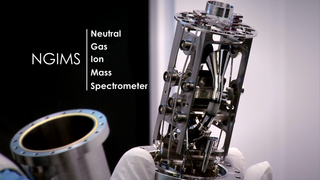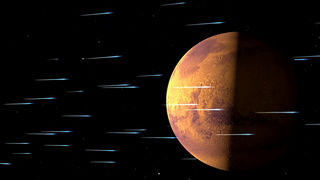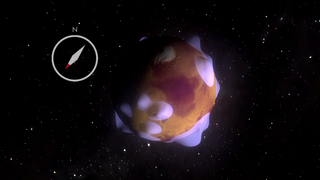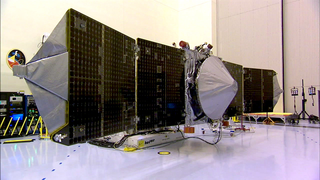Sun
Planets and Moons
ID: 11498
To planetary scientists, the Martian atmosphere presents an intriguing mystery: today it's a thin, cold wisp of carbon dioxide with just one percent the pressure of Earth's atmosphere, but long ago it was thick and warm enough to support lakes and rivers on the Martian surface. How did Mars lose so much of its early atmosphere? Scientists think that the solar wind may be responsible, and NASA's Mars Atmosphere and Volatile EvolutioN (MAVEN) spacecraft is designed to find out. The instruments of MAVEN's Particles & Fields package will study the interaction of the solar wind with Mars's upper atmosphere, helping scientists to better understand how Mars became the freeze-dried planet that we see today.
MAVEN Particles & Fields Package
Related
For More Information
Credits
Michael Lentz (USRA): Lead Animator
Chris Meaney (HTSI): Animator
Chris Smith (HTSI): Animator
Dan Gallagher (USRA): Video Editor
Robert Lin (University of California at Berkeley): Interviewee
Dan Gallagher (USRA): Producer
Robert Lin (University of California at Berkeley): Scientist
David L. Mitchell (Space Sciences Laboratory, University of California at Berkeley): Scientist
Aaron E. Lepsch (ADNET Systems, Inc.): Project Support
David Silberberg: Project Support
Rob Andreoli (Advocates in Manpower Management, Inc.): Videographer
Kevin Deane (Oakville Lane Productions, Inc.): Videographer
Chris Meaney (HTSI): Animator
Chris Smith (HTSI): Animator
Dan Gallagher (USRA): Video Editor
Robert Lin (University of California at Berkeley): Interviewee
Dan Gallagher (USRA): Producer
Robert Lin (University of California at Berkeley): Scientist
David L. Mitchell (Space Sciences Laboratory, University of California at Berkeley): Scientist
Aaron E. Lepsch (ADNET Systems, Inc.): Project Support
David Silberberg: Project Support
Rob Andreoli (Advocates in Manpower Management, Inc.): Videographer
Kevin Deane (Oakville Lane Productions, Inc.): Videographer
Please give credit for this item to:
NASA's Goddard Space Flight Center
NASA's Goddard Space Flight Center
Short URL to share this page:
https://svs.gsfc.nasa.gov/11498
Mission:
MAVEN: Mars Atmosphere and Volatile EvolutioN
This item is part of these series:
Narrated Movies
MAVEN Instrument Profiles
Goddard TV Tape:
G2013-003 -- MAVEN Particles and Fields
Keywords:
SVS >> HDTV
SVS >> Mars
SVS >> Solar Wind
SVS >> MAVEN
SVS >> Solar System >> Planets >> Mars >> Atmosphere
NASA Science >> Sun
NASA Science >> Planets and Moons
SVS >> Magnetometer
SVS >> Particles and Fields
https://svs.gsfc.nasa.gov/11498
Mission:
MAVEN: Mars Atmosphere and Volatile EvolutioN
This item is part of these series:
Narrated Movies
MAVEN Instrument Profiles
Goddard TV Tape:
G2013-003 -- MAVEN Particles and Fields
Keywords:
SVS >> HDTV
SVS >> Mars
SVS >> Solar Wind
SVS >> MAVEN
SVS >> Solar System >> Planets >> Mars >> Atmosphere
NASA Science >> Sun
NASA Science >> Planets and Moons
SVS >> Magnetometer
SVS >> Particles and Fields















